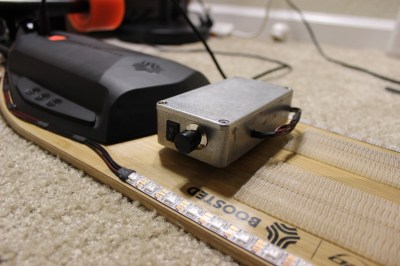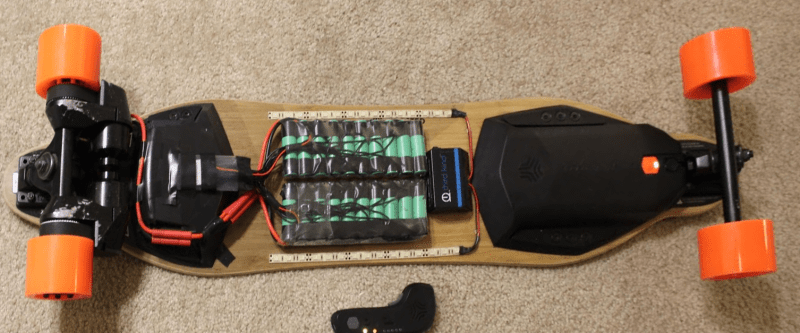Long-time Hackaday reader [Andrew Rossignol] bought a Boosted-brand electric skateboard while he was living in NYC. While the batteries more than sufficed for his commute in the Big Apple, he ran out of juice when he moved to the Left Coast, leaving him three miles short of a ten mile trip.
Faced with the unthinkable fate of pushing his skateboard like a Neanderthal, [Andrew] added more batteries. There’s great detail about how he chose the battery chemistry and the particulars of charging and something about load balancing, so it’s definitely worth a read if you’re building an electric vehicle.
 But once [Andrew] had some surplus battery capacity on board (tee hee!) he thought of ways to waste it. The natural solution: tons of RGB LED underlighting.
But once [Andrew] had some surplus battery capacity on board (tee hee!) he thought of ways to waste it. The natural solution: tons of RGB LED underlighting.
Still not content with an off-the-shelf solution (which wouldn’t let him recharge the batteries without unplugging the lights), he ended up rolling his own with an Arduino and some WS2812s. The nicest touch? Keeping it all out of the elements in a sweet aluminum box, hiding the cable salad within.
There’s a lot to be said for the good industrial design of something like the Boosted skateboard, but if you’d rather DIY, we’ve been covering electric skateboard for a while now. It’s nice to see how battery and motor technology have changed since then, too. Compare and contrast this recent build with that old-school version and with [Andrew’s] build that was covered in this post. We live in good times.
















Nice board! You might want to protect the extra batteries with a skid plate. One good curb scrape or other road hazard could cause a flaming underglow effect.
im curious why he decided to mix the battery types and have to contend with two charging systems than an all out replacement of the existing battery pack with the new chemistry
that being said with a bit of reading on the web, you can now build an electric long board with much better performance than the boosted board for the same price.
Andrew is wrong in one thing. Mixing battery chemistries, even though “FULL” and “EMPTY” voltages match, will NOT lighten the load on the batteries.
SUPPOSE you have a 4.2V max, 3.7V nominal battery and pair it with a 4.1V max, 3.6V nominal battery, both will have a “plateau” at their nominal voltage. You’ll “throw away” a few percent of the 4.2V max battery by only charging it to 4.1V, but that can be acceptable. (Andrew is doing the same!)
But when you discharge, you’ll first discharge both to about 3.7V, then the 3.7V nominal battery will provide ALL (or at least most of) the current until it is almost drained, Then the 3.6V battery will plateau and provide ALL the current for a while.
So: When charging or discharging a pack with mixed batteries, make sure you respect the maximum charge or discharge current of the fussiest battery in the pack!
Author of the original article here:
My understanding is that the distribution of the load will be a function of the internal resistance of the individual packs (which, is also a function of how much energy is still stored in each pack). I don’t think my setup will ever be in a situation where one pack is supplying ALL of the energy under normal usage. I agree that it will not be distributed evenly, however.
It might be possible for one pack to supply ALL of the energy if I was to discharge the internal LiFE battery entirely. When the remote tells me I am out of energy I stop riding the board to avoid damaging the internal cells.
My background is primarily software so I am happy to be proven otherwise.
He has the INR18650-25R’s listed as 35A cells, when they are in fact 20A cells. Also, nice use of a Hammond box.